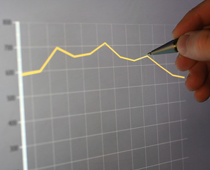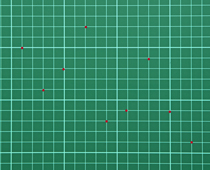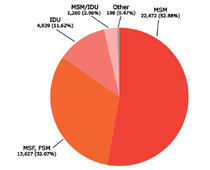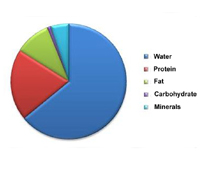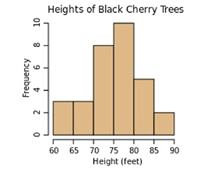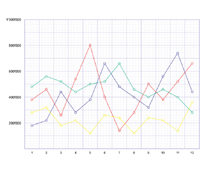In this GCSE Biology quiz we look at some of the many types of graphs and charts and find out how to choose the appropriate one to present different types of data. Scatter graphs, pie charts and bar charts are examples of some of the different ways used by scientists to present their data. It isn't always easy to know which one to use in which situation but if you learn a few simple 'rules', you will find it a lot easier. It all comes down to what type of data you need to present and what information you want from the data.
Raw data is the data that you obtain from an experiment, for example, you may have a list of the numbers of people in your class who can and cannot roll their tongues; the list of results is the raw data. Once you have your raw data, you need to decide on its type and how it is to be used. In some cases, you may just want to present the results of a survey but in other cases, you may want to use it to make predictions or to spot patterns.
[readmore]
Continuous data is data that contains units of measurement that can have any value. Examples of this are cm (and other measurements of length), temperature, volts and amps. Take cm for instance, you are not just limited to 1 cm, 2 cm, and so on - you could have any value - 1.25, 3.9, 625.29853 and so on. This type of data is often used to make predictions, for example, predicting the current through a resistor at a voltage that you haven't measured.
Discrete (also called discontinuous) data is data that contains only specific values. Examples of this would be the tongue rolling data (can roll their tongue or can't roll their tongue are the only two possible values) or eye colour. This data needs to be presented differently and can only be used to make vague predictions. For example, using tongue rolling data from your class to predict how many people in the whole school can and can't roll their tongues would only be approximate as the data depends on genetics which are random.
Line graphs and histograms are appropriate when presenting continuous data. You would use a line graph where points can be joined and a histogram where you are presenting a range of data against a specific variable, e.g. an age range against height. If you need to find a correlation between two sets of data, you would use a scatter graph with a line of best fit. Discrete data can be presented as bar charts and data consisting of percentages which total 100% can be shown as pie charts. It may also be appropriate to present data as pictograms but that is much less common in scientific subjects than in other subjects.
[/readmore]
Please click on any of the smaller images below to get a larger picture.
|
1.
|
This is an example of which type of chart? ![]()
|
|
| [ ] |
Line graph |
| [ ] |
Histogram |
| [ ] |
Bar chart |
| [ ] |
Pie chart |
|
|
|
2.
|
What sort of chart is this? ![]()
|
|
| [ ] |
Pie chart |
| [ ] |
Line graph |
| [ ] |
Bar chart |
| [ ] |
Scatter graph |
|
|
|
3.
|
Identify this type of chart. ![]()
|
|
| [ ] |
Line graph |
| [ ] |
Bar chart |
| [ ] |
Histogram |
| [ ] |
Scatter graph |
|
|
|
4.
|
Points just plotted without joining or bars is known as a ... ![]()
|
|
| [ ] |
scatter graph |
| [ ] |
line graph |
| [ ] |
pie chart |
| [ ] |
bar chart |
|
|
|
5.
|
This shows the population of a country as time goes on. The population is... ![]()
|
|
| [ ] |
increasing |
| [ ] |
decreasing |
| [ ] |
the same |
| [ ] |
increasing and decreasing |
|
|
|
6.
|
This chart is a type of... ![]()
|
|
| [ ] |
bar chart |
| [ ] |
line graph |
| [ ] |
mean |
| [ ] |
data |
|
|
|
7.
|
In the following pie chart, which has the largest percentage? ![]()
|
|
| [ ] |
MSM |
| [ ] |
MSF |
| [ ] |
IDU |
| [ ] |
Other |
|
|
|
8.
|
Using this pie chart, showing the composition of the human body, which of the following is the body mainly made of? ![]()
|
|
| [ ] |
Protein |
| [ ] |
Fat |
| [ ] |
Carbohydrate |
| [ ] |
Water |
|
|
|
9.
|
Looking at this histogram of the height of cherry trees, why is this a histogram and not a bar chart? ![]()
|
|
| [ ] |
Height is continuous data |
| [ ] |
Height is discontinuous data |
| [ ] |
The data is averaged |
| [ ] |
The data is accurate |
|
|
|
10.
|
Looking at this line graph covering a 12-hour period, which hour shows the highest amount? ![]()
|
|
|
|
|
1.
|
This is an example of which type of chart? ![]()
|
|
| [ ] |
Line graph |
| [ ] |
Histogram |
| [ ] |
Bar chart |
| [x] |
Pie chart |
|
|
|
2.
|
What sort of chart is this? ![]()
|
|
| [ ] |
Pie chart |
| [ ] |
Line graph |
| [x] |
Bar chart |
| [ ] |
Scatter graph |
|
|
|
3.
|
Identify this type of chart. ![]()
|
|
| [x] |
Line graph |
| [ ] |
Bar chart |
| [ ] |
Histogram |
| [ ] |
Scatter graph |
|
|
|
4.
|
Points just plotted without joining or bars is known as a ... ![]()
|
|
| [x] |
scatter graph |
| [ ] |
line graph |
| [ ] |
pie chart |
| [ ] |
bar chart |
|
|
|
5.
|
This shows the population of a country as time goes on. The population is... ![]()
|
|
| [ ] |
increasing |
| [ ] |
decreasing |
| [ ] |
the same |
| [x] |
increasing and decreasing |
|
|
|
6.
|
This chart is a type of... ![]()
|
|
| [x] |
bar chart |
| [ ] |
line graph |
| [ ] |
mean |
| [ ] |
data |
|
|
|
7.
|
In the following pie chart, which has the largest percentage? ![]()
|
|
| [x] |
MSM |
| [ ] |
MSF |
| [ ] |
IDU |
| [ ] |
Other |
|
|
|
8.
|
Using this pie chart, showing the composition of the human body, which of the following is the body mainly made of? ![]()
|
|
| [ ] |
Protein |
| [ ] |
Fat |
| [ ] |
Carbohydrate |
| [x] |
Water |
|
|
|
9.
|
Looking at this histogram of the height of cherry trees, why is this a histogram and not a bar chart? ![]()
|
|
| [x] |
Height is continuous data |
| [ ] |
Height is discontinuous data |
| [ ] |
The data is averaged |
| [ ] |
The data is accurate |
|
|
|
10.
|
Looking at this line graph covering a 12-hour period, which hour shows the highest amount? ![]()
|
|
|
|


